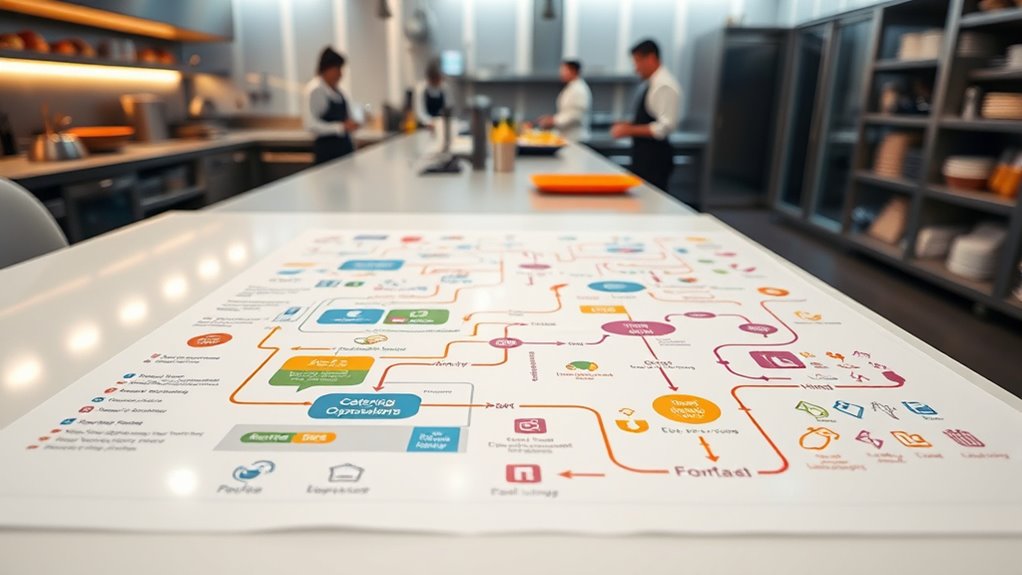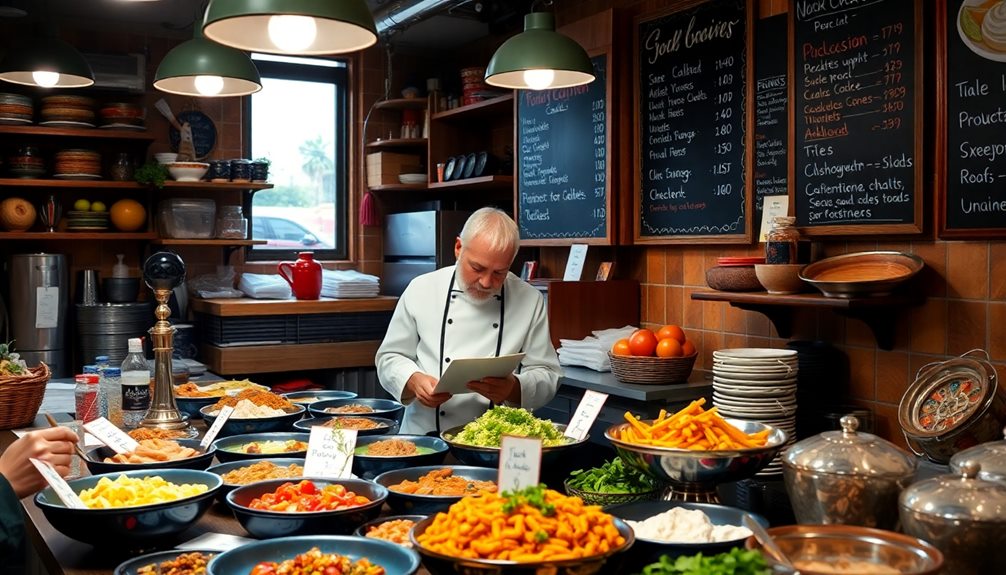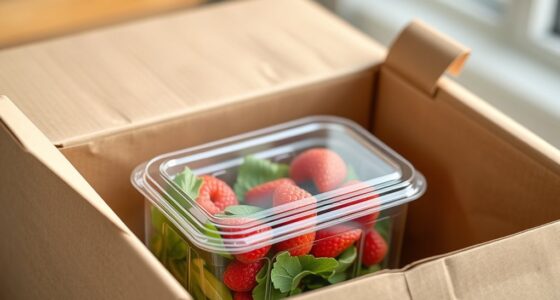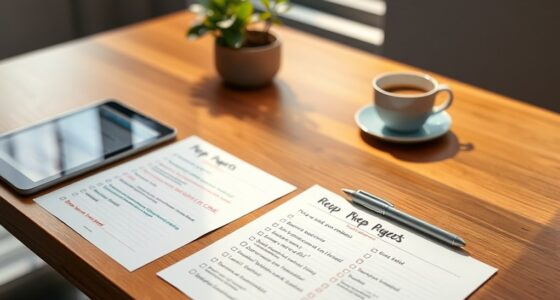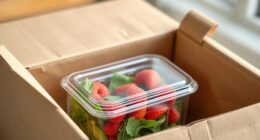A catering operations workflow map guides you through each step of event execution, beginning with evaluating client needs and planning the menu based on preferences, dietary restrictions, and theme. Next, you coordinate food production, manage logistics for transportation, and guarantee timely delivery. At the venue, you set up and serve efficiently before wrapping up with cleanup and collecting feedback. If you keep exploring, you’ll discover more tips to streamline your catering process.
Key Takeaways
- Outline the step-by-step process from client needs assessment to post-event cleanup.
- Define roles and responsibilities for each stage of food preparation, logistics, and service.
- Highlight key tasks like menu planning, sourcing ingredients, and coordinating transportation.
- Include details on venue setup, guest interaction, and efficient food service execution.
- Emphasize feedback collection and continuous improvement strategies post-event.
Assessing Client Needs and Planning the Menu
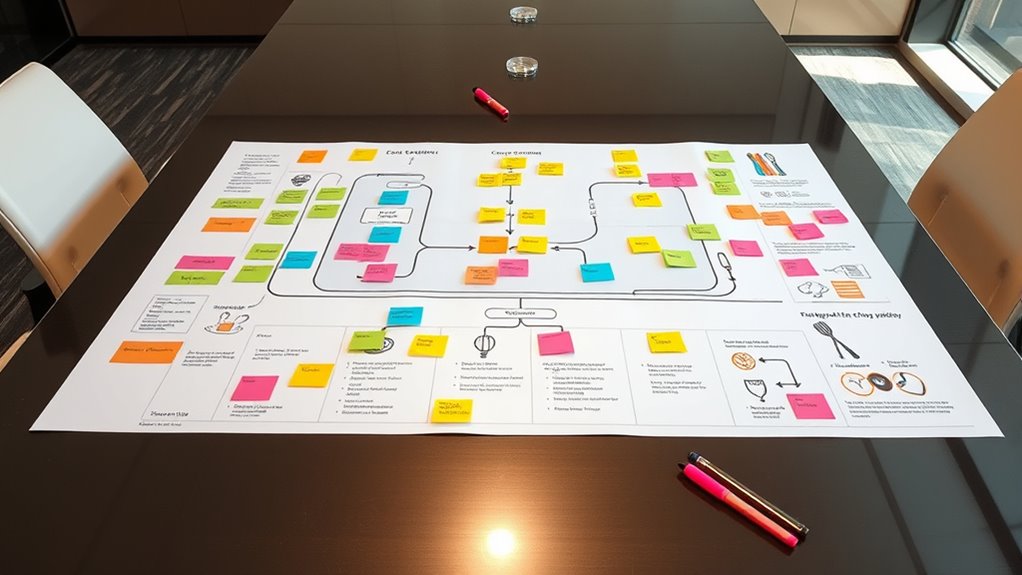
Understanding your client’s needs is the essential first step in planning a successful catering menu. You need to gather detailed information about their event, including the type of occasion, number of guests, and preferred cuisine. Ask about dietary restrictions, allergies, and special preferences to guarantee all guests are accommodated. Clarify the event’s theme or style, as this influences menu choices. Discuss the desired service format, whether buffet, plated, or stations. This helps you tailor the menu to fit both the client’s vision and practical considerations like budget and venue limitations. Additionally, considering the historic significance of a location can inspire themed menu options that enhance the overall experience. By thoroughly evaluating these needs upfront, you set a strong foundation for creating a menu that delights guests and meets client expectations, ensuring a seamless catering experience.
Preparing and Coordinating Food Production
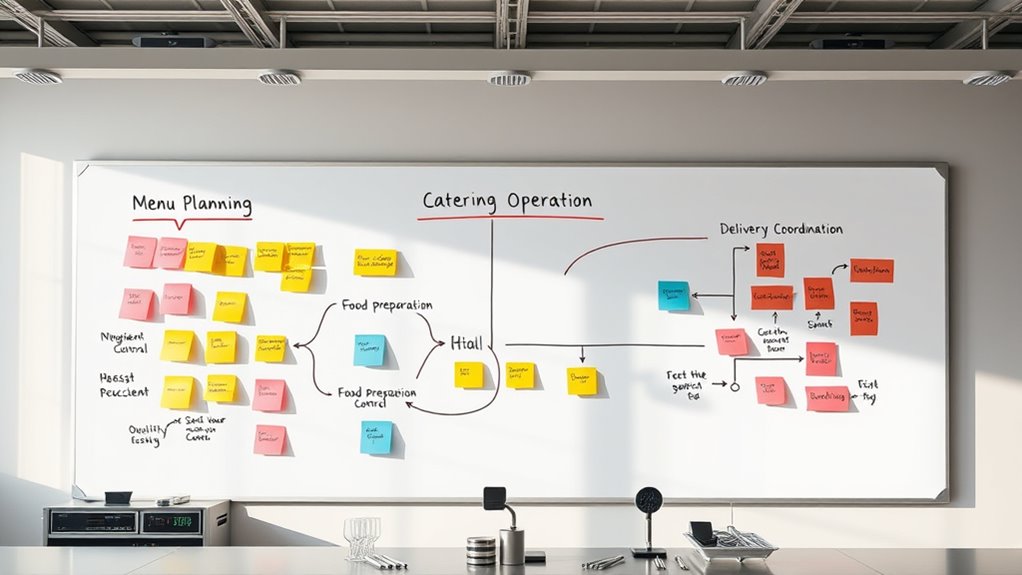
Once the menu is finalized, you can focus on preparing and coordinating food production to guarantee everything runs smoothly. Start by organizing your kitchen stations and assigning tasks to your team, ensuring each member understands their responsibilities. Check that all ingredients are available and prepped according to the recipes, reducing delays during cooking. Establish a timeline for cooking, plating, and assembly, aiming to finish before the event start time. Keep communication clear and constant among staff to handle any issues promptly. Monitor cooking progress closely, adjusting heat and timing as needed. Prioritize quality control, tasting dishes to ensure they meet standards. Incorporating efficient workflow systems can further streamline the process and prevent bottlenecks. By coordinating these steps efficiently, you set the stage for a seamless service, delivering fresh, well-presented food to your clients.
Managing Logistics and Transportation

Effective management of logistics and transportation is essential to guarantee that food and equipment arrive at the event on time and in perfect condition. You need to plan routes carefully, considering traffic, distance, and delivery windows. Coordinate with drivers and suppliers to ensure everyone is aligned on schedules and expectations. Use tracking systems to monitor shipments in real-time, so you can address delays immediately. Pack items securely to prevent damage during transit, and verify quantities and quality beforehand. Communicate clearly with your team about pickup locations and delivery times. Proper documentation, such as delivery receipts and manifests, helps keep everything organized. By staying proactive and detail-oriented, you ensure a smooth flow of supplies, helping your event run seamlessly.
Setting Up and Serving at the Venue
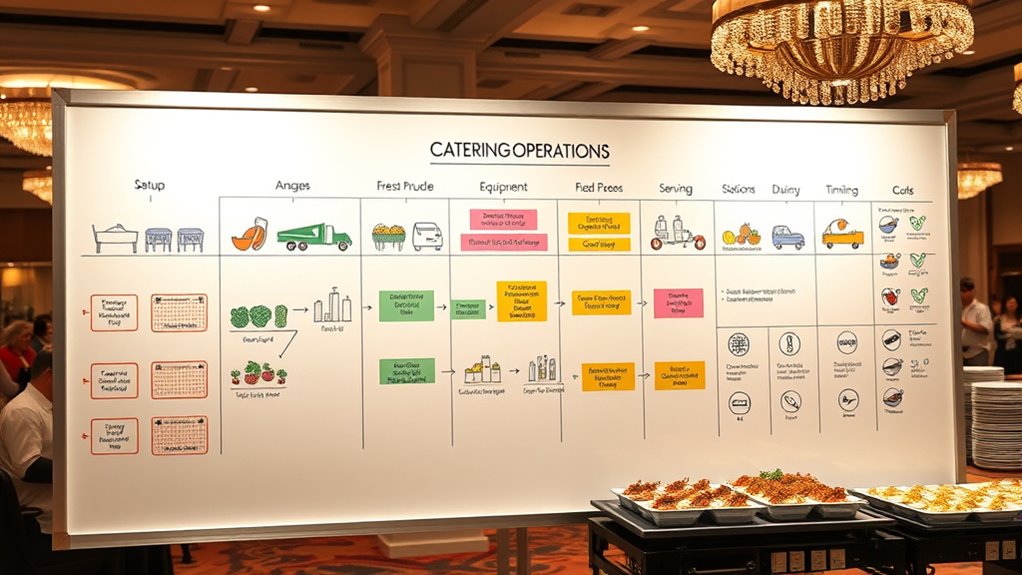
After coordinating logistics and ensuring all supplies arrive on time, the focus shifts to setting up your space and serving guests smoothly. Begin by arranging tables, chairs, and stations according to your floor plan, ensuring easy access for both staff and guests. Set up buffet lines, beverage stations, and service areas, double-checking that all equipment functions properly. Keep supplies like plates, utensils, and napkins within reach but organized. As guests arrive, greet them warmly and guide them to their seats or service areas. Efficiently serve food and drinks, maintaining a steady pace without rushing. Stay attentive to guest needs, addressing any issues promptly. A well-organized setup and attentive service create a positive experience that reflects your professionalism. Considering the variety of flavors and preferences, offering dairy-free options can enhance guest satisfaction and inclusivity.
Post-Event Cleanup and Feedback Collection

As the event concludes, focus on efficiently cleaning up the venue and gathering valuable feedback from your guests. Quick cleanup minimizes disruption, so assign teams for trash removal, surface cleaning, and equipment breakdown. Meanwhile, engage guests by asking for their feedback through surveys or casual conversations to identify areas for improvement. Use this information to refine future events. Incorporating grocery savings strategies can also be beneficial for planning post-event catering supplies and minimizing costs.
Frequently Asked Questions
How Do I Handle Last-Minute Menu Changes Effectively?
When dealing with last-minute menu changes, you should stay calm and communicate quickly with your team. Confirm the new items and adjust ingredient orders immediately to avoid shortages. Update all relevant staff and ensure the kitchen understands the changes. Flexibility is key, so stay organized and prioritize essential updates. By staying proactive and maintaining clear communication, you can handle last-minute changes smoothly and keep your event running seamlessly.
What Safety Protocols Are Essential During Food Transportation?
To guarantee safety during food transportation, you need to prioritize proper handling, secure packaging, and temperature control. You should verify that all containers are sealed properly, keep hot foods hot and cold foods cold, and regularly check temperature gauges. Additionally, you must maintain cleanliness to prevent contamination, follow hygiene protocols diligently, and ensure your vehicle is clean and well-maintained. These steps protect your food, your reputation, and your customers’ health.
How Can Technology Improve Workflow Efficiency?
You can boost workflow efficiency by leveraging technology in your operations. Implementing tools like digital scheduling and real-time tracking helps you stay organized and respond quickly to changes. Automating order processing reduces errors and saves time, while using communication apps keeps everyone updated effortlessly. These tech solutions streamline tasks, minimize delays, and improve overall productivity, making your catering process smoother and more reliable.
What Are Common Challenges in Multi-Event Scheduling?
When managing multiple events, you often face scheduling conflicts, resource allocation issues, and communication gaps. These challenges can lead to missed deadlines, double bookings, or overlooked details. To tackle this, you should implement centralized scheduling tools, establish clear communication channels, and regularly update your plans. By staying organized and proactive, you can minimize errors, facilitate smooth handovers, and deliver successful events without unnecessary stress or confusion.
How to Manage Client Expectations During Service?
Did you know that 70% of clients feel satisfied when their expectations are clearly communicated? When managing client expectations during service, you should set transparent, realistic goals from the start. Communicate proactively, listen carefully to their needs, and provide regular updates. This approach builds trust and minimizes misunderstandings, ensuring a smoother experience for everyone involved. Stay flexible, address concerns promptly, and always aim to exceed their expectations whenever possible.
Conclusion
Now you’re ready to conquer the catering world with this workflow map. Follow these steps, and you’ll turn chaos into a perfectly orchestrated symphony of deliciousness and smooth operations. Picture yourself effortlessly handling every detail, making clients rave and events legendary. With this guide, you’ll be the superhero of catering, transforming even the most formidable event into a seamless, unforgettable feast. Get ready to impress, because nothing will stop your culinary empire from reigning supreme!
